Understanding the Role of Errorless Learning in ABA Therapy
Applied Behavior Analysis (ABA) therapy serves as a foundational approach in supporting individuals with autism, focusing on improving essential skills through scientifically validated techniques. A key teaching strategy within ABA is errorless learning, designed to facilitate easier and more confidence-building skill acquisition by minimizing errors during the learning process. This article explores how errorless learning operates within ABA therapy, its core principles, implementation strategies, and the benefits it offers to learners with autism, aiming to enhance therapy effectiveness and promote independence.
What is ABA Therapy and Its Benefits for Individuals with Autism?
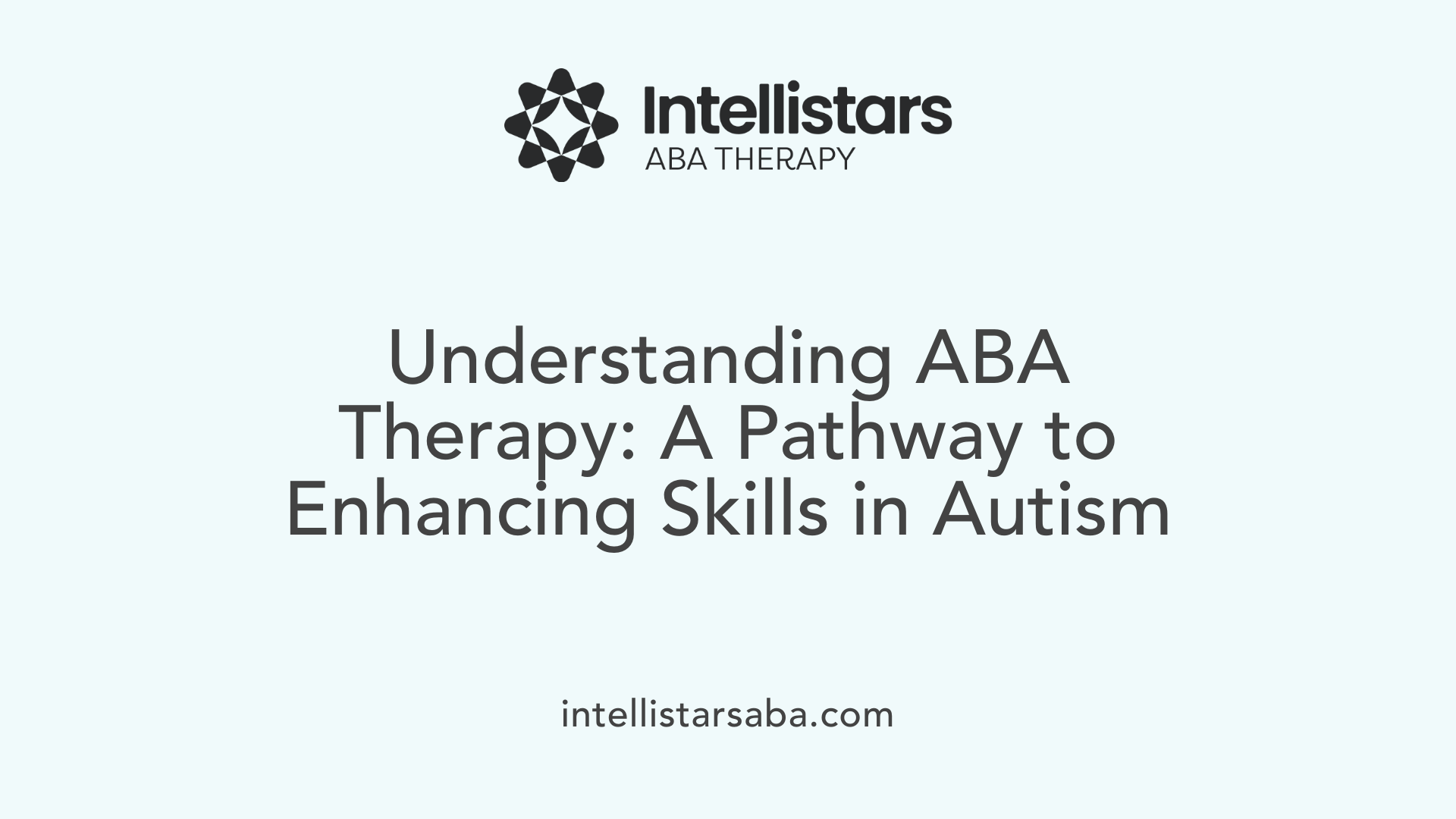
What is Applied Behavior Analysis (ABA) therapy, and how does it help individuals with autism?
Applied Behavior Analysis (ABA) therapy is a scientifically validated method that applies principles of learning to improve communication, social, and daily living skills in individuals with autism. It focuses on enhancing positive behaviors while reducing problematic ones through evidence-based strategies such as positive reinforcement and systematic data collection.
Goals of ABA in autism treatment
The primary aim of ABA therapy is to increase independence and improve quality of life. This is achieved by breaking down complex skills into manageable steps, teaching each skill carefully, and reinforcing progress. ABA also targets reducing behaviors that may interfere with learning or social interaction.
Settings for ABA therapy delivery
ABA programs are tailored to each individual's needs and can be administered in various environments, including homes, schools, and clinics. Qualified behavior analysts oversee these programs to ensure effective implementation and consistent progress monitoring.
Effectiveness and outcomes of ABA therapy
Research supports ABA as an effective intervention, particularly when started early and delivered intensively. Individuals undergoing ABA therapy often show notable improvements in communication, social skills, and daily functioning, which contribute to more meaningful and lasting behavior changes.
Core Behavioral Principles Underpinning ABA Therapy
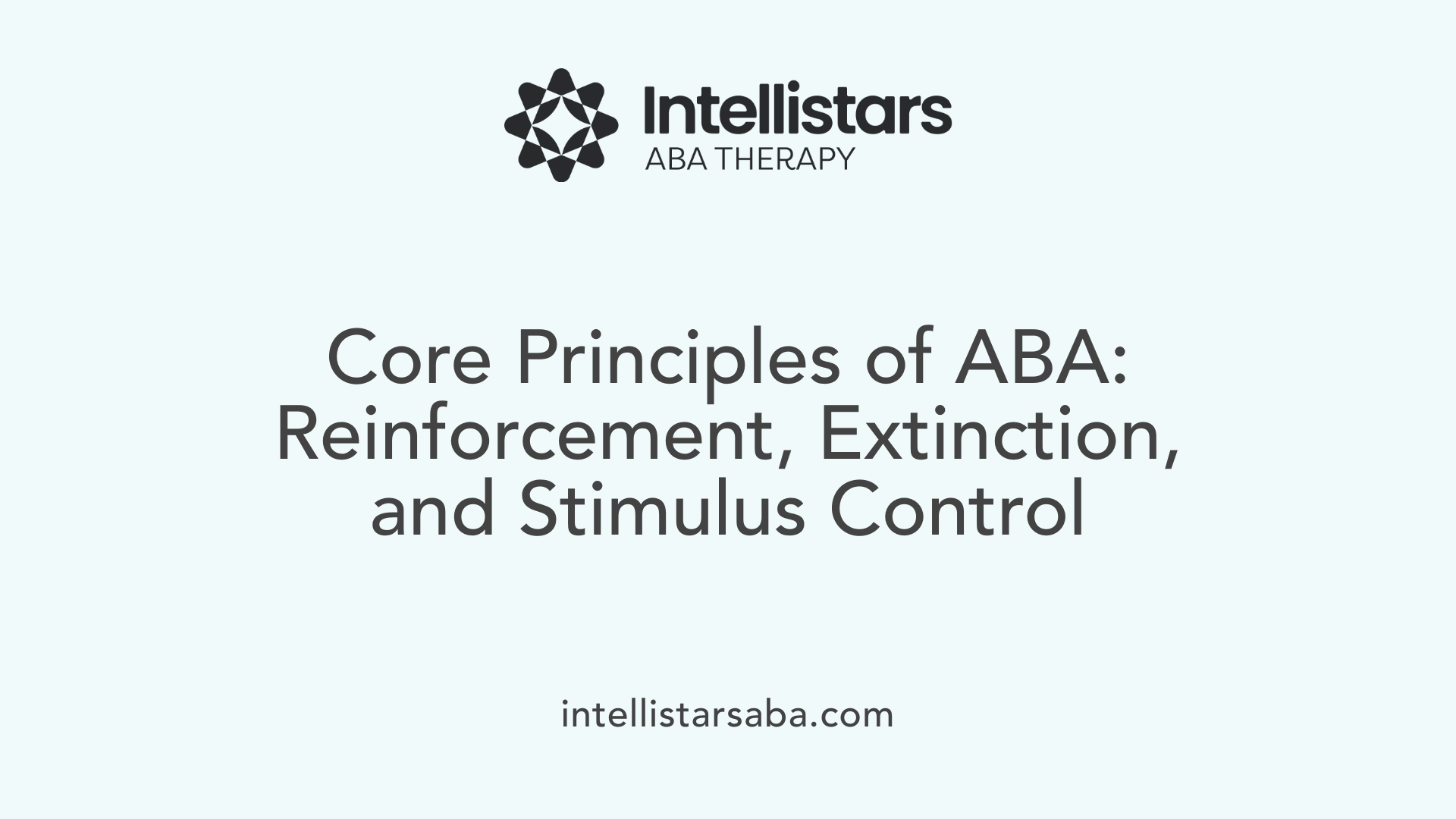
What are the core principles underlying behavioral analysis used in autism therapy?
Applied Behavior Analysis (ABA) therapy is firmly rooted in the scientific study of learning and behavior. Its core behavioral principles include reinforcement, punishment, extinction, and stimulus control, each playing a distinct role in shaping behaviors.
Reinforcement strengthens desired behaviors by providing positive consequences following the behavior, increasing the likelihood that the behavior will occur again. Conversely, punishment is used selectively to reduce undesired behaviors by applying unfavorable outcomes.
Extinction involves discontinuing the reinforcement that maintains a behavior, which leads to the decrease or elimination of that behavior over time. Meanwhile, stimulus control refers to the manipulation of antecedents or environmental cues to prompt appropriate behaviors.
ABA therapy often utilizes the ABC model (Antecedent, Behavior, Consequence) to analyze what triggers a behavior (antecedent), the behavior itself, and its outcomes (consequences). This model helps therapists understand and systematically modify behaviors.
How does personalized intervention design fit into ABA?
Therapists design personalized interventions based on thorough assessment and data collection. Each plan considers an individual’s unique strengths, challenges, developmental level, and preferences. Tailored strategies ensure that interventions are effective and relevant, supporting skill acquisition and behavior reduction in meaningful contexts.
This personalized approach enables consistent, adaptive implementation of ABA across diverse environments such as home, school, and therapy sessions, promoting generalization and long-term independence.
| Principle | Description | Role in Therapy |
|---|---|---|
| Reinforcement | Increases desired behaviors by adding rewards | Encourages skill acquisition and positive behavior |
| Punishment | Decreases undesired behaviors by applying consequences | Used cautiously to reduce harmful behaviors |
| Extinction | Removal of reinforcement to reduce behavior | Helps eliminate unwanted behaviors |
| Stimulus Control | Managing antecedents to influence behavior | Promotes appropriate responses to environmental cues |
| ABC Model | Analyzes antecedent, behavior, and consequence | Guides behavior assessment and modification |
| Personalized Design | Tailors intervention to individual needs | Maximizes effectiveness and relevance |
Who Delivers ABA Therapy and What Are Their Qualifications?

Roles of BCBAs, RBTs, and BCATs
Applied Behavior Analysis (ABA) therapy is delivered by a team of professionals with distinct roles. The Board Certified Behavior Analyst (BCBA) is primarily responsible for designing, overseeing, and adjusting individualized treatment plans. Often holding a master's degree, BCBAs undergo rigorous training, supervised fieldwork, and certification exams. Registered Behavior Technicians (RBTs) and Board Certified Autism Technicians (BCATs) support by implementing therapy sessions directly with clients under BCBA supervision. This team approach ensures high-quality care.
Certification and Training Requirements
BCBAs require graduate-level education, supervised practical experience, and must pass a comprehensive certification exam conducted by the Behavior Analyst Certification Board (BACB). RBTs and BCATs complete specialized training programs and competency assessments designed to prepare them for working directly with clients. Their certifications verify that they can deliver therapy accurately according to treatment protocols.
Supervision and Ethical Standards
Supervision by a qualified BCBA is mandated to maintain therapy quality and client safety. All ABA professionals follow ethical guidelines set forth by the BACB, emphasizing client welfare, confidentiality, and data-driven decision-making. Regular oversight and ethical adherence are crucial to effective and responsible therapy delivery.
Importance of Qualified Professionals in Therapy Delivery
The expertise of qualified professionals ensures that ABA therapy is tailored to each individual's unique needs, promotes skill acquisition, and upholds scientific best practices. Skilled providers also adapt methods like errorless learning to maximize progress and reduce frustration during sessions. Ultimately, correct qualifications and ethical practice enhance the effectiveness and integrity of ABA therapy programs.
Measuring the Effectiveness of ABA Therapy in Autism Treatment
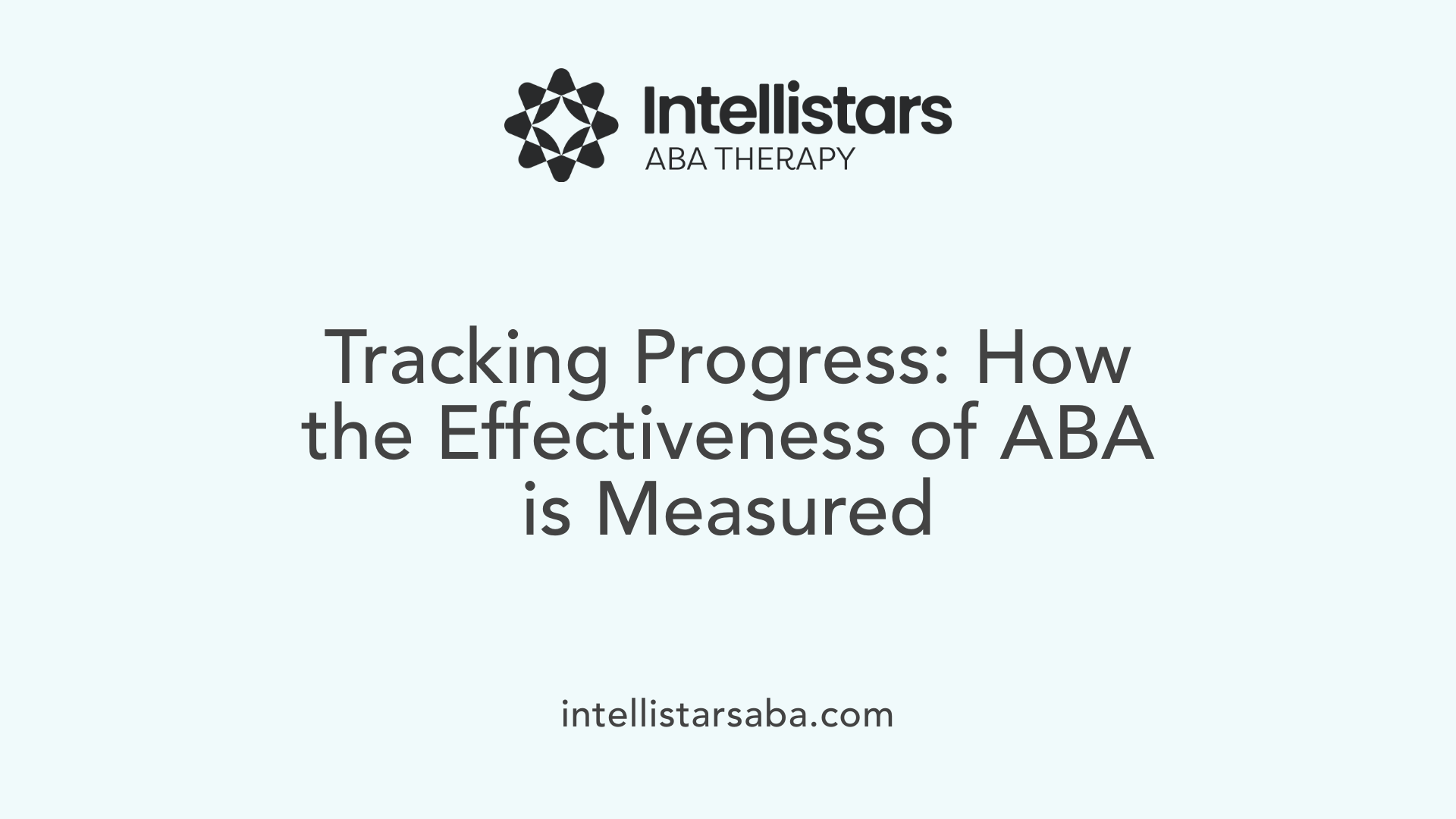
How is the effectiveness of ABA therapy measured in autism treatment?
The effectiveness of ABA therapy in autism treatment is primarily measured through systematic ongoing data collection and analysis. Clinicians track measurable progress by recording specific behaviors related to communication, social skills, and overall skill acquisition. This data is often documented numerically and displayed visually using graphs, which helps monitor trends and improvements over time.
Data collection methods
Data collection involves observing and recording targeted behaviors during therapy sessions and in natural environments like home or school. Methods include frequency counts, duration recording, and task completion rates. Precise and consistent data gathering by Registered Behavior Technicians (RBTs) ensures that progress can be accurately evaluated.
Monitoring progress in communication and social skills
Improvements in communication and social skills are vital indicators of ABA therapy success. Clinicians assess milestones such as increased verbal requests, better eye contact, initiation of social interactions, or reduced challenging behaviors. These are closely tracked to determine the effectiveness of teaching strategies like errorless learning.
Using behavior data for treatment adjustments
Collected data guides treatment modifications by highlighting which interventions promote skill acquisition and which might require changes. If progress slows or plateaus, therapists may revise prompts, reinforcement schedules, or target skills to better suit the learner’s needs.
Indicators of therapy success
Success indicators include consistent improvements in target behaviors, increased independence, reduced frustration, and enhanced learner confidence. Caregiver feedback and the learner’s engagement across settings also help confirm the positive impact of therapy.
| Area of Measurement | Data Type | Purpose |
|---|---|---|
| Communication Skills | Frequency of verbal requests, initiation of interaction | Track growth in expressive abilities |
| Social Skills | Duration and quality of social engagement | Assess social development |
| Behavioral Changes | Reduction in challenging behaviors | Evaluate behavior management effectiveness |
| Skill Acquisition | Task completion rates | Monitor learning progress |
Foundations of Errorless Learning in ABA Therapy
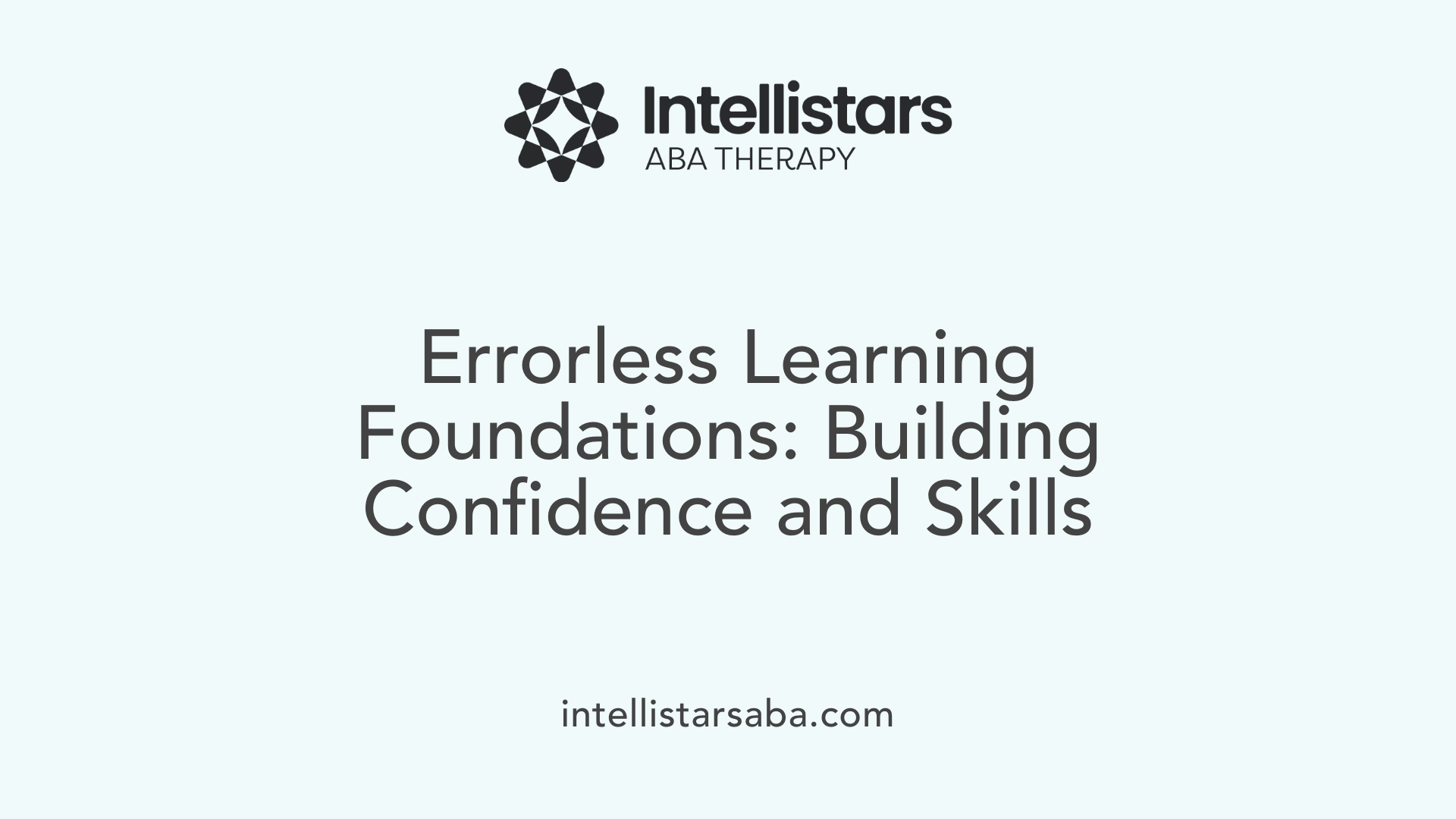
What is Errorless Learning and What Are Its Goals?
Errorless learning is a teaching method used in Applied Behavior Analysis (ABA) therapy designed to help learners acquire new skills without making mistakes. Its main goal is to prevent errors before they occur by providing immediate and adequate support, allowing learners, especially those with cognitive and communication challenges, to build skills confidently and independently.
How Does Errorless Learning Prevent Learner Mistakes?
This approach works by guiding the learner toward the correct response using various prompts from the start. By carefully selecting a skill and breaking it down into smaller components, therapists can provide just enough assistance so that errors rarely happen. If a mistake seems likely, prompts are adjusted to redirect the learner effectively, minimizing frustration.
What Role Do Immediate and Sufficient Prompts Play?
Prompts are essential in errorless learning and come in many forms, such as physical, verbal, visual, gestural, and modeled cues. These prompts are provided immediately to ensure the learner responds correctly and confidently. Over time, prompts are systematically faded to encourage independent responses, using techniques like most-to-least prompting and time delay.
How Does Errorless Learning Create a Positive and Motivating Environment?
By preventing errors, this method reduces the learner’s stress and anxiety, which often accompany mistakes and correction. Positive reinforcement is given immediately following correct responses, boosting motivation and engagement. This scaffolding fosters a supportive learning atmosphere that helps learners develop self-esteem and greater willingness to try new challenges.
Prompting Strategies and Systematic Fading in Errorless Learning
What Types of Prompts Are Used in Errorless Learning?
Errorless learning employs a range of prompts to guide correct responses and minimize errors. These include:
- Physical Prompts: Direct hand-over-hand assistance.
- Verbal Prompts: Spoken cues or instructions.
- Visual Prompts: Pictures or gestures providing visual guidance.
- Gestural Prompts: Pointing or indicating the correct action.
- Model Prompts: Demonstrating the correct behavior or response.
The choice of prompt depends on the learner's current skill level and needs.
How Are Prompt Hierarchies and Techniques Applied?
Prompts are arranged in a hierarchy from most to least intrusive. For example, physical prompts are more intrusive, whereas visual prompts are less so. This hierarchy supports strategies like:
- Most-to-Least Prompting: Starting with more supportive prompts and gradually reducing assistance.
- Time Delay: Introducing a pause before providing the prompt to encourage independent responding.
- Graduated Guidance and Stimulus Fading: Slowly decreasing physical assistance or gradually altering prompts to encourage independence.
How Is Systematic Prompt Fading Carried Out?
Systematic fading involves gradually removing prompts as the learner masters each step. This promotes independence, prevents prompt dependency, and reinforces skill acquisition. The fading process is carefully timed and adjusted based on the learner’s responses.
What Role Does Positive Reinforcement Play?
Positive reinforcement is critical throughout errorless learning. Immediate praise or rewards following the correct response reinforce desired behaviors, increase motivation, and build confidence. Reinforcement helps the learner associate success with positive outcomes, fostering a supportive learning environment.
These prompting and fading strategies ensure learners receive enough support to succeed while gradually gaining independence, a cornerstone of effective errorless learning in ABA therapy.
Applications and Benefits of Errorless Learning for Individuals with Autism
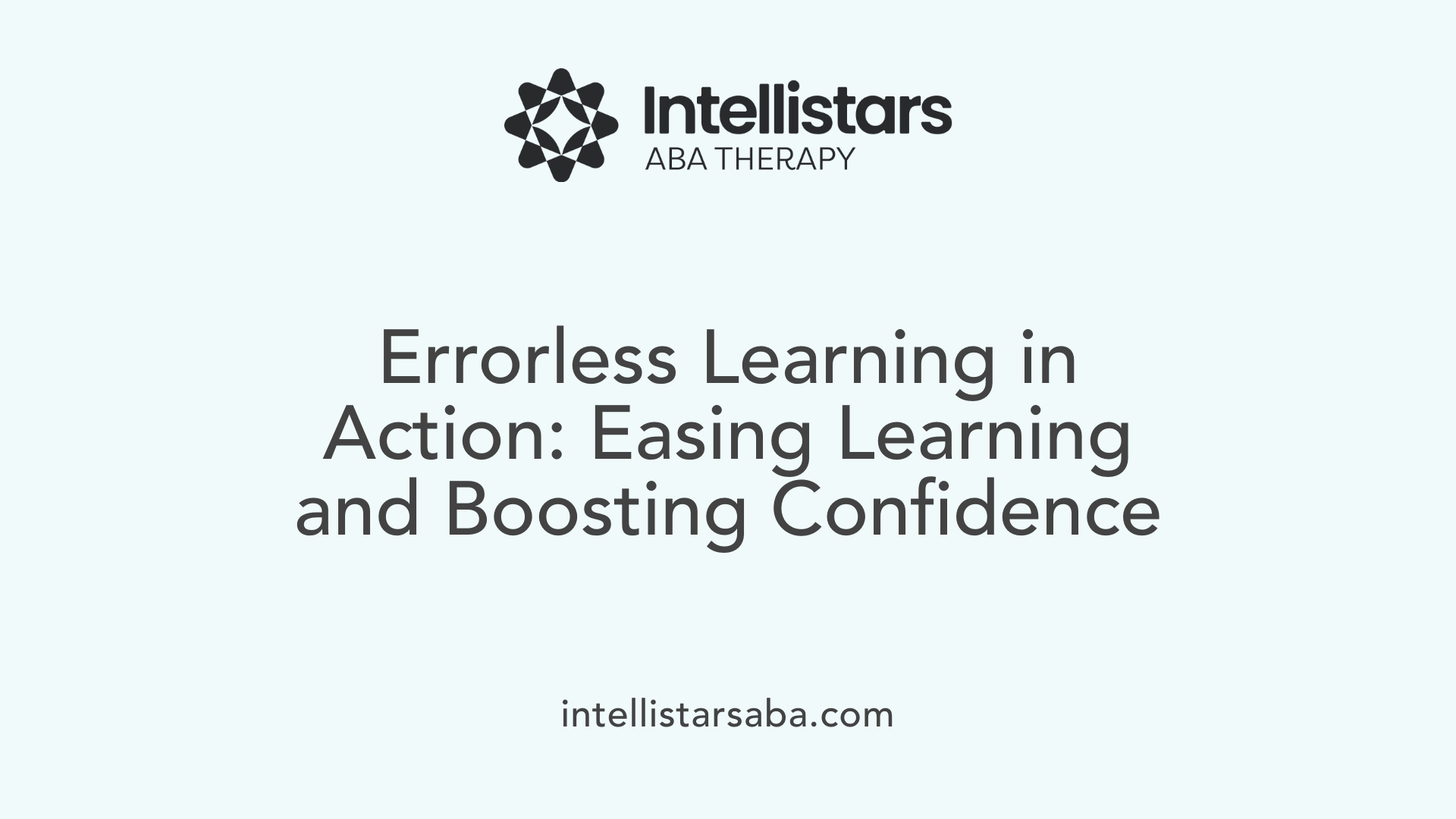
Teaching new or challenging skills early in therapy
Errorless learning is especially valuable in the early stages of therapy for individuals with autism. It focuses on teaching new or difficult skills by preventing errors before they occur. This method uses carefully selected prompts—ranging from physical to visual cues—that are gradually faded as the learner gains independence. By structuring learning in this supportive way, therapists set a strong foundation for skill development and reduce potential frustration.
Reducing frustration, anxiety, and learned helplessness
One major advantage of this approach is the reduction of negative emotional responses during learning. Since the learner is guided to correct responses immediately, errors are minimized, which limits feelings of failure or discouragement. This supportive environment decreases anxiety and helps prevent learned helplessness, a state where individuals feel incapable of mastering tasks due to repeated failure.
Building confidence and motivation
Errorless learning also fosters confidence by ensuring success with each step of skill acquisition. Positive reinforcement is given promptly after correct responses, boosting motivation and encouraging continued engagement. The approach promotes a positive learning experience that helps learners feel competent and eager to participate.
Faster skill acquisition and improved retention
By systematically guiding learners to the correct responses and gradually removing prompts, errorless learning accelerates the acquisition of new skills. Research shows that this technique not only enables quicker learning but also improves retention and generalization of skills. Learners benefit from better mastery and are more likely to maintain skills over time.
These benefits make errorless learning a powerful tool in ABA therapy, contributing to effective and compassionate support for individuals with autism as they develop valuable skills.
Practical Steps for Implementing Errorless Learning in ABA Therapy
Assessment and Skill Analysis
The first step in implementing errorless learning involves conducting a thorough assessment of the learner's current abilities and challenges. This helps identify the target skill and any areas that require special accommodations. Breaking down the chosen skill into manageable, smaller components is essential to guide effective teaching.
Breaking Skills Into Small Steps
Once the target skill is selected, it is broken down into sequential, simple steps that the learner can master progressively. This systematic approach ensures that each component is taught with sufficient prompting and reinforcement, promoting smoother skill acquisition.
Establishing Prompt Hierarchies and Reinforcement Schedules
Next, a hierarchy of prompts is established, ranging from the most intrusive (e.g., physical prompts) to the least intrusive (e.g., visual cues). Prompts are provided immediately to prevent errors and are faded gradually using techniques such as most-to-least prompting and time delay. Positive reinforcement is delivered consistently to encourage correct responses and boost motivation.
Ongoing Documentation and Data-Driven Adjustments
Consistent data collection and documentation by Registered Behavior Technicians (RBTs) are critical throughout the learning process. Tracking progress enables the team to adjust strategies, fade prompts effectively, and ensure that learning objectives are met. This data-driven approach helps maintain individualized support tailored to the learner’s developmental level and preferences.
Limitations and Combining Errorless Learning with Other ABA Techniques
Who benefits most from errorless learning?
Errorless learning works best for learners who are new to skills or tend to get easily frustrated during learning. By preventing errors right from the start, it helps reduce anxiety and builds confidence early on. This is especially important for children and individuals with cognitive challenges, such as autism, who might struggle with error correction or feedback.
When might errorless learning be less effective?
While errorless learning excels at teaching new or challenging skills, it can be limited when the goal shifts to generalization or developing problem-solving abilities. Since the approach focuses heavily on preventing errors through prompts, it may not provide enough opportunities for learners to practice correcting their own mistakes or applying skills in varied contexts without support.
How is errorless learning combined with other ABA techniques?
Typically, errorless learning is integrated with methods like shaping, chaining, and natural environment teaching to create a well-rounded therapy plan. Shaping gradually reinforces closer approximations to a target behavior, chaining connects individual skills into sequences, and natural environment teaching promotes skill use in everyday settings. Together, these approaches balance initial error prevention with eventual independence and adaptability.
How is errorless learning tailored to individual needs?
Practitioners customize errorless learning plans based on each learner’s age, developmental level, learning style, and specific challenges. This individualized approach ensures prompts and fading techniques fit the person's unique profile, optimizing engagement and fostering growth. Consistent progress monitoring helps adjust strategies to maintain effectiveness and support skill mastery.
Harnessing Errorless Learning to Maximize ABA Therapy Outcomes
Errorless learning represents a powerful strategy within Applied Behavior Analysis therapy, focusing on minimizing errors to foster positive, confident, and independent learners. By systematically providing and fading prompts alongside consistent positive reinforcement, therapists can build foundational skills more quickly and with less frustration, especially for individuals with autism. Supporting the principles of ABA and delivered by qualified professionals, errorless learning contributes to more effective therapeutic outcomes when tailored to individual needs. Integrating this approach thoughtfully within comprehensive ABA programs ensures that children and adults alike can achieve meaningful progress toward their full potential.
References
- Errorless Learning in ABA Therapy: The Ultimate Guide
- Errorless Learning in ABA: Techniques and Benefits
- Mastering Skills with Errorless Learning in ABA Therapy
- The Role of Errorless Learning in ABA: Reducing ...
- Errorless Learning In ABA Therapy
- Efficacy of Interventions Based on Applied Behavior ...
- Applied Behavior Analysis (ABA)
- ASD Intervention Effectiveness: How Do We Measure ...
- How to Measure ABA Therapy's Effectiveness
- Board Certified Behavior Analysts (BCBA)






